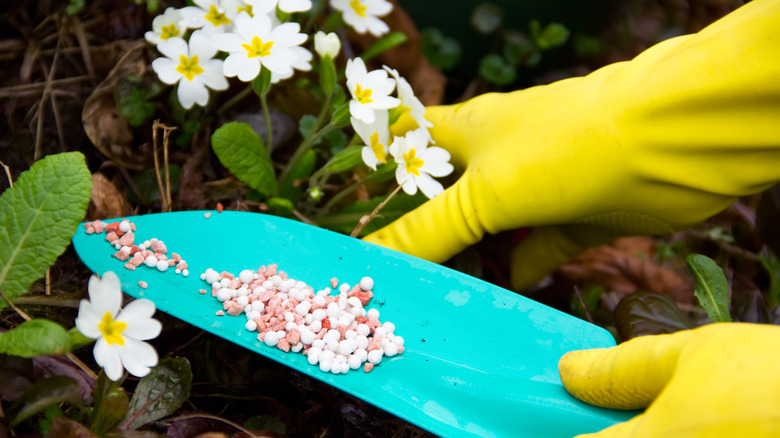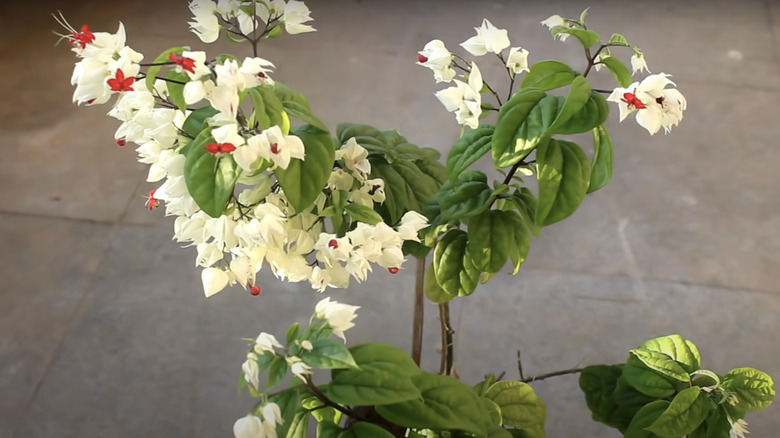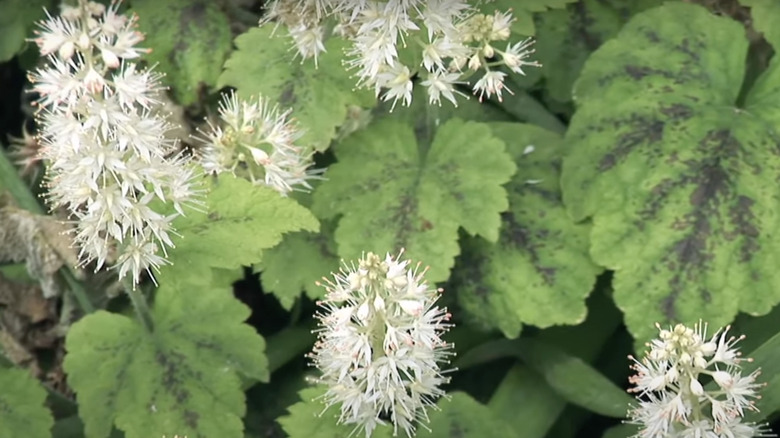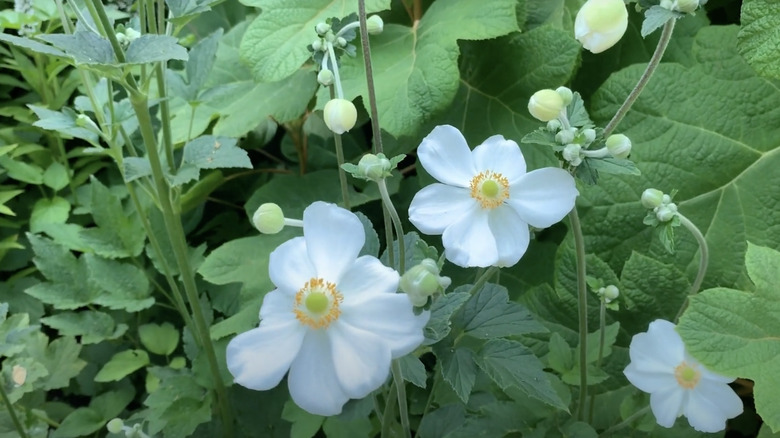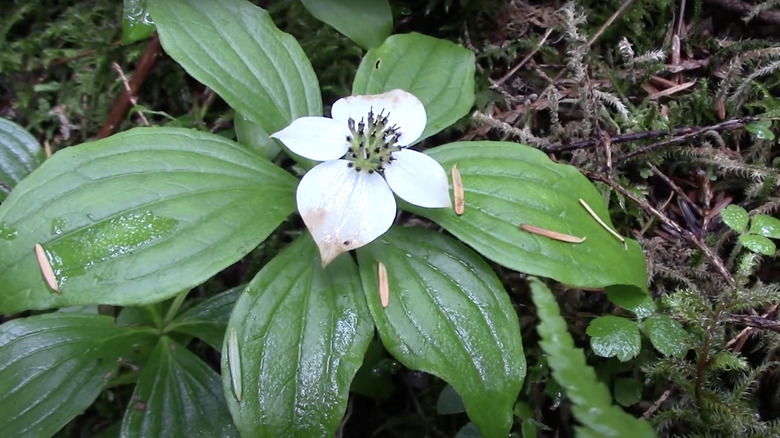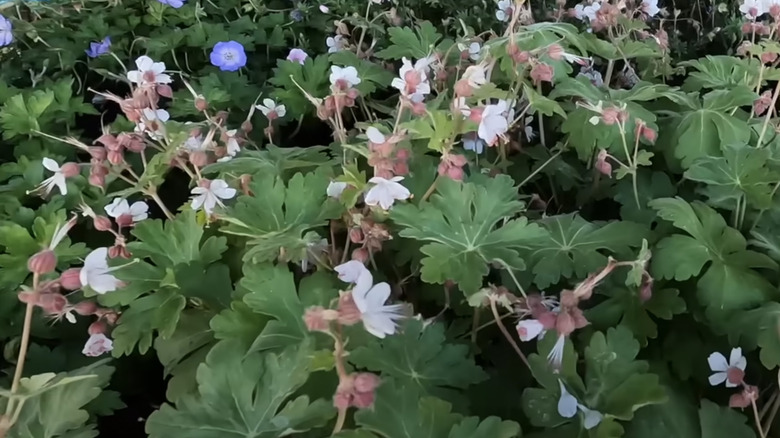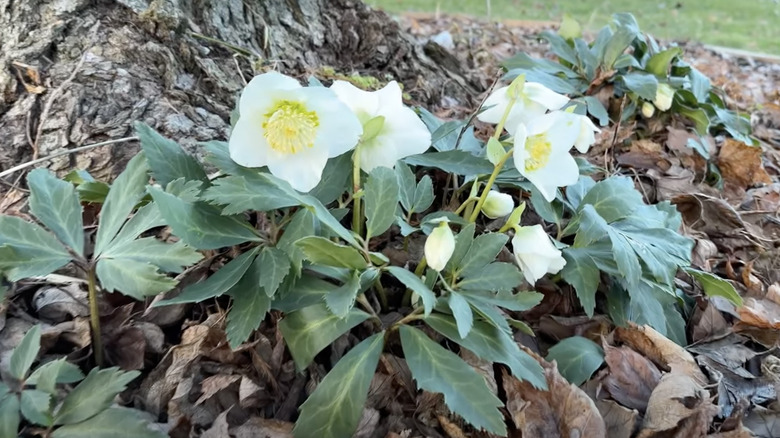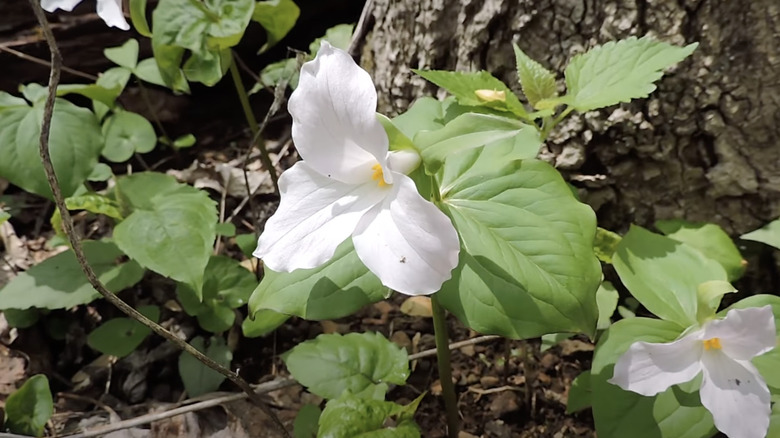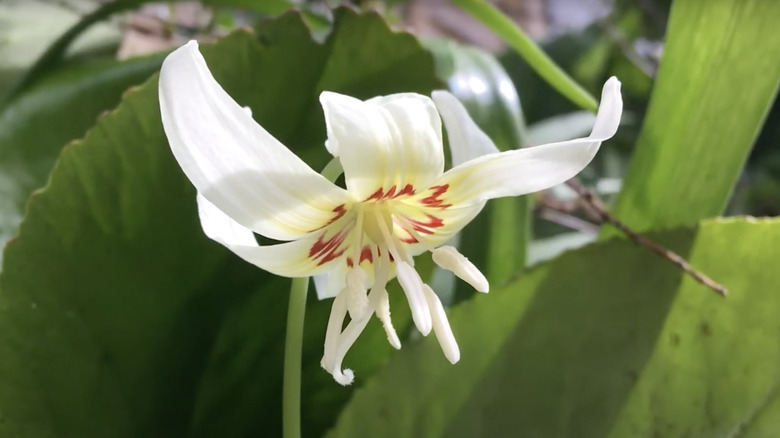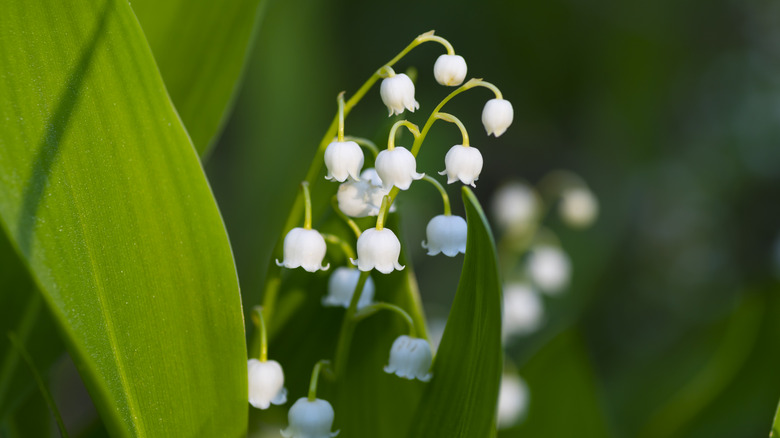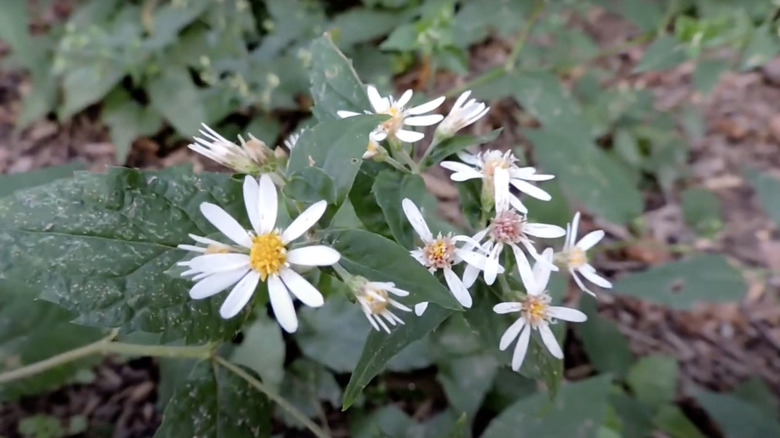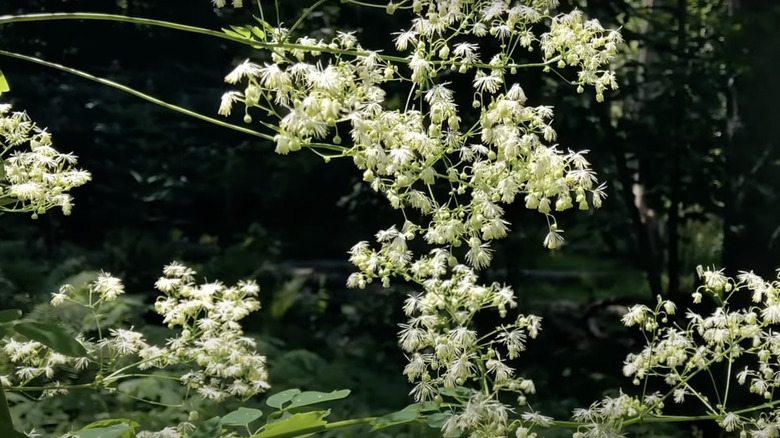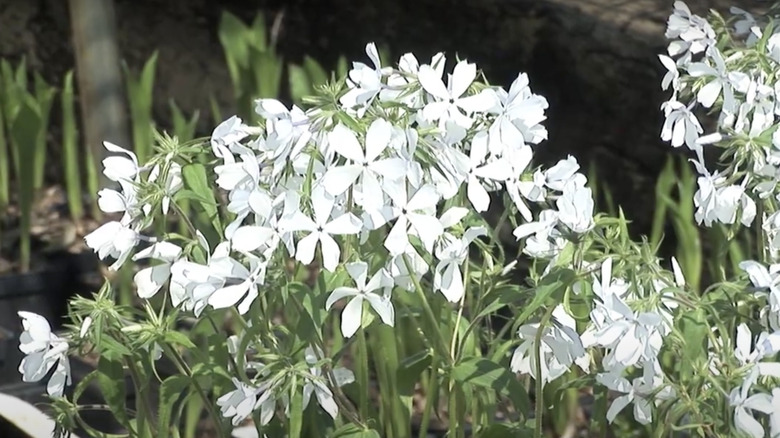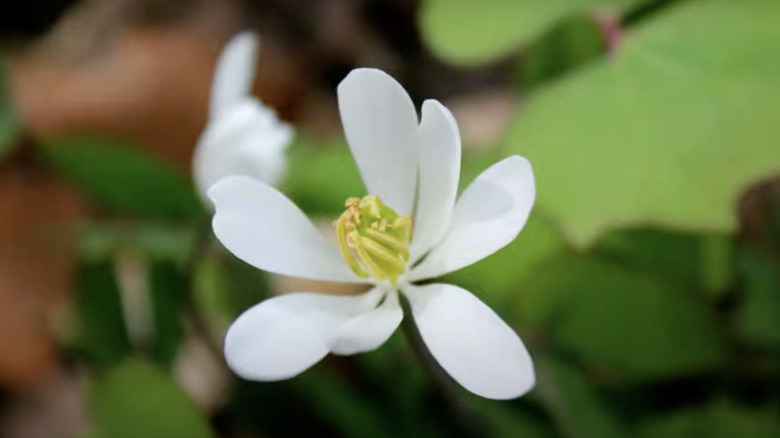13 Stunning White Flowers To Brighten Up Your Shade Garden
Want to give your shade garden a gorgeous glow with white flowering plants? Shade gardens can be just as eye-catching as sun-drenched border beds, you just have to pick the right plant species. White blossoms can instantly brighten up a shady space, adding an ethereal look to a variety of verdant areas. While typical shade-friendly plants include ferns and mosses, there are also various flowering options. From pretty white-flowered annuals to cream-colored perennials, you can find the perfect blossoms for your outdoor space.
There are numerous species of flora that don't just survive but thrive in areas with limited sunlight. Whether you're looking to freshen up your patio or backyard, there are several white-tinted blooms to consider. As long as you select species well-suited to shade conditions, and provide proper care, you can create a stunning shade garden with white accents. No matter the season, ensure that your shade garden shines by choosing the right white blossoms.
Add soft whimsy with white bleeding hearts
Bleeding hearts are a top pick for shade gardens due to their resilience and unique blossoms. Typically, this whimsical plant displays bright pink flowers. However, the Alba variation produces pure white blooms. They grow approximately 24-30 inches tall and are deer-resistant. These perennial beauties are an ideal option if you're searching for a low-maintenance, white flower. They bloom from late April to late May, offering a beautiful spring spectacle.
Caring for bleeding hearts is relatively simple and endlessly rewarding. Does your garden get a touch of sun? Bleeding hearts can flourish in both full shade or partial sunlight. They need moist soil to survive, but good drainage is essential to promote healthy growth. However, keep in mind that bleeding hearts go dormant in the summer months. This may cause a gap in your garden if you don't surround bleeding heart plants with some leafy groundcovers. To prevent this, plant them next to other perennials like astilbes, hostas, and ferns. If you have any furry friends with access to your yard, keep in mind that bleeding hearts are very toxic to dogs and should never be consumed by your pets.
Create a gorgeous groundcover with foamflowers
If your garden lies under heavy shade, foamflowers are an ideal option. They fall under the family group of Saxifragaceae. Foamflowers were named after their foam-like clusters of blooms that appear in the springtime. The shade-loving blossoms also attract pollinators like bees and butterflies. The color of their flowers ranges from snow white to pink. If you're searching for a groundcover option that loves low light, foamflowers check several boxes.
Keep in mind that foamflowers grow slowly, expanding every year. Most variations multiply through the production of underground rhizomes. However, the hybrid Wherry's foamflower does not spread by rhizomes and instead forms clumps without runners. All foamflowers require moist soil that is kept well-drained. They grow primarily in damp forests, bottomlands, and shore inlets. Thanks to their native status, foamflowers are relatively easy to grow if given the right conditions and suffer from few pest issues. Foamflowers bring a delicate beauty to shaded gardens.
Enjoy a fall show with late-season autumn anemones
If you're searching for a flower to brighten up your garden in the fall, consider autumn anemones. These late-blooming perennials take a year or two to reach their final form, but they are worth the wait. The flowers grow about 12 inches tall, and they spread quickly after becoming fully established. Autumn anemones primarily bloom between late July and October. Their blossoms come in both white and pink varieties, and the small flowers will add visual variation to your shade garden in the later months.
Although they prefer shade, anemones will survive with some sunlight. Be careful not to overwater your specimens, as they do not tolerate excessive moisture. Be aware that if you plant Japanese anemones, which are prone to bloom latest, they can be invasive in cool climate areas. They are also toxic to both humans and domestic animals, so make sure to keep them away from any children or pets and wear gloves when working with this pretty perennial.
Get blossoms and berries with creeping dogwood
For a plant that presents several stunning transformations throughout the year, creeping dogwood is a perfect choice. It starts completely green and then grows small, white flowers in the spring and summer. Later in the year, the blossoms are replaced by bright red berries. The leaves also change from green to dark red. The plants typically reach about 3-6 inches in height when fully grown, making them an ideal low-profile groundcover option.
Creeping dogwood is best grown in cool, moist climates. It is native to North American woodlands and mountain regions, as well as areas of Greenland and Northeast Eurasia. If you live in a particularly cold climate, creeping dogwood is a great plant to try due to its hardy nature. Plant it underneath large shrubs and small trees to ensure heavy shade. It is also ecosystem-friendly, because it offers food for animals throughout the year. Creeping dogwood is non-toxic, making it a great plant to consider if you have children or dogs roaming around your garden.
Add some eye-catching edging with geranium Spessart
For a flower that is light and bright with a subtle touch of color, you can't beat geranium Spessart. These pretty geraniums are primarily white but include a delicate hint of pink. Their impressive resilience allows them to grow in a wide range of environments. In fact, their alternate title is, "hardy geraniums." They emit a fresh, airy scent and change colors through the season. The green foliage turns to a golden red in the autumn, making it equally attractive even after the flowers have gone.
You can grow geranium Spessart in full or partial shade. These plants are ideal for decorating rockeries or for edging out pathways. Their long-blooming flowers attract pollinators and butterflies. They are also deer and rabbit-resilient, making them an ideal choice if you live in a wooded area with wildlife. There is no known toxicity to pets, adding to their widespread appeal.
Create impact with some stunning snowbells (aka the Christmas rose)
Snowbells are one of the most visually impactful, shade-friendly blooms. They offer large, eye-catching flowers that flourish in the shade. Also known as the "Christmas rose," snowbells blossom as early as late winter and stay open until the start of spring. Their unusual blooming schedule is a great way to add beauty to your shade garden while most other plants lie dormant. The flowers also face outward, which is atypical for many other hellebores.
Although they are relatively resilient, snowbells cannot tolerate heavy winds. They should be partially sheltered from any strong cold breezes to be best preserved throughout the winter. Consider planting them underneath large bushes, shrubs, or trees. Snowbells are largely pest-free, except for in areas that are prone to slugs and aphids. You should always wear gloves when planting and caring for your snowbells to avoid skin irritation. They are also toxic for both humans and animals to ingest. All plants that fall under the Helleborus umbrella, including snowbells, could be considered invasive as they are not native to North America. However, invasiveness varies between species and climates.
Enjoy long-lasting blooms with the herbaceous great white trillium
Great white trilliums have a unique appearance and exceptional longevity. The large, white flowers sport just three petals each, making them easily recognizable. They are native to shady woodlands and bloom primarily in the mid-spring to early summer. Later in the season, the flowers develop a pink tint, then turning into single red berries before returning to the earth for another season.
For an ideal first-year cycle, plant your great white trilliums in early fall while the soil is still warm. If you missed the deadline, you also can choose to plant them in early spring. Their flowers attract pollinators, but they can also draw in hungry deer. If you live in a deer-heavy area, be aware that your trilliums might be targeted by hungry Cervidae. The plants are not highly toxic to humans or dogs, but it is not recommended to ingest trilliums as they may cause digestive discomfort thanks to a high saponin content.
Celebrate spring with white Erythroniums
White Erythroniums are also known as "dog's tooth violets" because they grow from bulbs that resemble canine teeth. The flowers, which start in the spring, have swept-back petals and appear almost star-like, adding a unique and exotic look to your shade garden. There are a couple of beautiful white varieties to choose from. The "Harvington Snowgoose" variation has petals with feathered edges, whereas the "White Beauty" alternative has crisp, white leaves that are dappled with copper.
While they are fairly easy to grow, the soil must be kept consistently moist and well-drained. Erythronium bulbs are vulnerable to drying out, so they're usually best propagated from established plants bought in pots. You can plant a variety of flora around them. A few complementary ornamentals to consider include hepaticas, trillium, and hellebores, which have similar soil, shade, and moisture requirements. Make sure to mulch your white Erythroniums every year with leaf mold to keep them healthy.
Seduce the senses with the sweet-scented lily of the valley
Lily of the valley is known for its bell-shaped, sweetly scented flowers. "Muguet," as it's known in French, thrives in cool, temperate weather. It is a tradition in France to give lily of the valley bouquets on the first of May. Before you rush to buy these unique blossoms, get familiar with everything you need to know before planting lily of the valley. While these flowers can be a stunning addition to your shade garden, there are a few important considerations.
Make sure to plant your lily of the valley mindfully, as it can spread quickly and become invasive. If you are worried about the bulbs overtaking your garden, it's best to plant them in pots for better containment. Lily of the valley adapts well to various soil conditions but prefers a consistently moist environment. This hardy lily rarely experiences issues with insects or pests. However, they are extremely toxic — and even deadly — to humans and animals.
Fill up bare spots with hardy white wood asters
Another late bloomer, white wood aster blossoms from late summer to fall. The plant can grow in partial to full shade and it is adaptable to both mildly acidic and neutral soils. It has deciduous foliage, but the leaves remain uniquely green in the autumn. The flowers present as small and daisy-like. They have narrow white petals with yellow centers.
While white wood asters may have invasive habits, it is not on the Federal noxious weed list. What's more, this native species plays an essential part in supporting forest life, and if you live in the eastern United States, can actually help support the ecosystem as butterflies and bees are attracted to the flowers. Because aster rhizomes can spread quickly, make sure to plant them at least 18 to 30 inches apart. The woody aster, different from the white wood aster, can be toxic to humans, but most asters are safe around both humans and animals.
Add height with fluffy and tall meadow rue
Tall meadow rue actually has fluffy stamens instead of petals, but this doesn't make their white blossoms any less attractive. Unsurprisingly, tall meadow rue can reach an impressive size, growing between 2-6 feet high. It can survive in damp or dry climates, but the leaves may turn yellow in arid areas. In cold regions, the leaves may take on a pink-ish hue in the fall. Typically, tall meadow rue blooms in late summer between July and early August.
Tall meadow rue will attract butterflies and other pollinators. It pairs well with several shade-friendly plants. If you're searching for other flowers that will grow happily next to your rue, consider Joe Pye weed, great blue lobelia, and red cardinal flowers. Joe Pye weed, the swamp weed look-alike, can attract both birds and pollinators and will make a pretty companion to tall meadow rue. All of the aforementioned plants love damp areas, but they can tolerate some sun. True to its name, tall meadow rue prefers swampy meadow settings — but its adaptability makes it highly resilient. Be sure to plant Joe Pye weed and meadow rue towards the back of your flower bed, as they will grow taller than lobelia and cardinal flowers.
Create dimension with cool-toned May Breeze woodland phlox
While technically a very light blue, May Breeze woodland phlox is an early spring blossom that has an icy white appearance. If your goal is to make your shade garden glow, opt for phlox divaricata. This variety produces fragrant flowers that will fill your garden with a gentle, sweet aroma. Plant your woodland phlox in an area with damp, well-drained soil. It can tolerate shade, but also thrives with some sunlight.
If your goal is to attract hummingbirds to your shade garden, woodland phlox will draw them in with its sweet scent. Once your phlox has become established, it will be able to survive drier conditions. This makes it extremely versatile if you live in an unpredictable climate. Woodland phlox creates an excellent groundcover as the plants spread easily, but they won't overtake your garden. It is considered very nonaggressive, and you can easily remove or transplant any phlox seedlings that pop up.
Choose low-maintenance twinleaf flowers for deep shade
Twinleaf is indigenous to the eastern United States. It is known for its distinctive appearance resembling fluttering butterfly wings. This beautiful white wildflower will thrive in your shade garden. It is extremely low-maintenance and will tolerate (and even thrive) in deep shade. The flowers bloom in April through May. Each plant has a single white flower with a yellow center.
This is a true, shade-loving plant, as it won't handle direct sun at all. It does best with less than three hours of sunlight every day. If you find yourself struggling with your twinleaf, try adding more shade rather than more light. Twinleaf can do well in calcareous soil, thanks to the inherent alkalinity. A few recommended plants to pepper around your twinleaf include: mayapples, rue anemones, and Dutchman's breeches. For more ideas on honing your green thumb, check out this article that covers a variety of beautiful flowers that grow perfectly in shade gardens.
